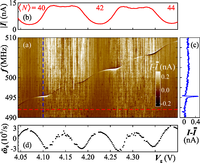Today's great news is that our manuscript "Nanomechanical characterization of the Kondo charge dynamics in a carbon nanotube" has been accepted for publication by Physical Review Letters.
The Kondo effect is a many-body phenomenon at low temperature that results from a quantum state degeneracy, as, e.g., the one of spin states in absence of a magnetic field. In its simplest case, it makes a quantum dot, in our case a carbon nanotube with some trapped electrons on it, behave very different for an even and an odd number of electrons. At an even number of trapped electrons, no current can flow through the nanotube, since temperature and applied bias voltage are too low to charge it with one more elementary charge; this phenomenon is called Coulomb blockade. Strikingly, at odd electron number, when two degenerate quantum states in the nanotube are available, Coulomb blockade seems not to matter, and a large current can flow. Theory explains this by assuming that a localized electron couples to electrons in the contacts, forming a combined, delocalized singlet quantum state.
What carries the Kondo-enhanced current, and how does the electric charge now accumulate in the carbon nanotube? We use the vibration of the macromolecule to measure this. As also in the case of, e.g., a guitar string, the resonance frequency of a nanotube changes when you pull on it; in the case of the carbon nanotube this is sensitive enough to resolve fractions of the force caused by a single elementary charge. From the vibration frequency, as function of the electrostatic potential, we calculate the average number of electrons on the nanotube, and can then compare the odd and even number cases.
A surprising result of our evaluation is that the charge trapped on the nanotube behaves the same way in the even and odd occupation case, even though the current through it is completely different. Sequential tunneling of electrons can model the charge accumulation, and with it the mechanical behaviour. The large Kondo current is carried by virtual occupation of the nanotube alone, i.e., electrons tunneling on and immediately off again so they do not contribute to the charge on it.
"Nanomechanical Characterization of the Kondo Charge Dynamics in a Carbon Nanotube"
K. J. G. Götz, D. R. Schmid, F. J. Schupp, P. L. Stiller, Ch. Strunk, and A. K. Hüttel
Physical Review Letters 120, 246802 (2018); arXiv:1802.00522
(PDF,
HTML,
supplementary information)
